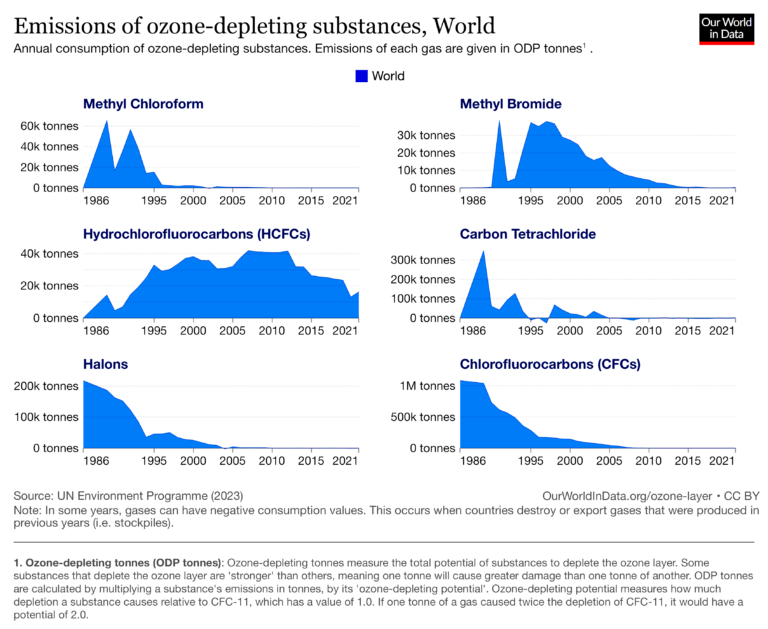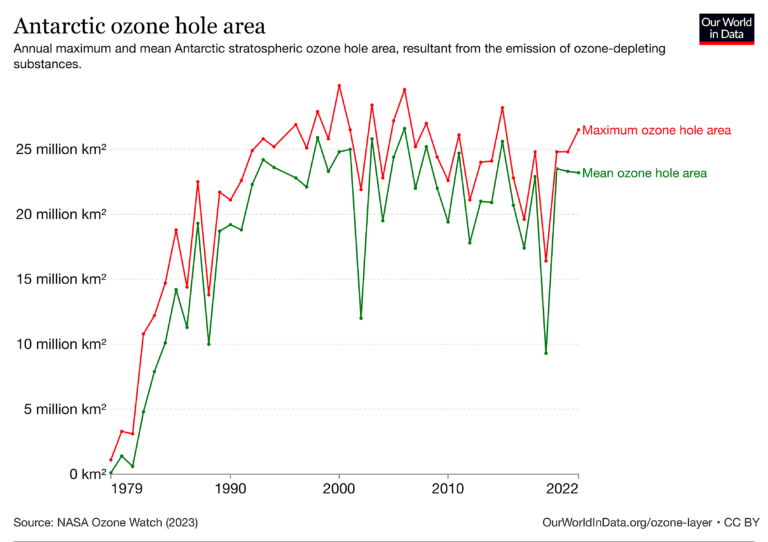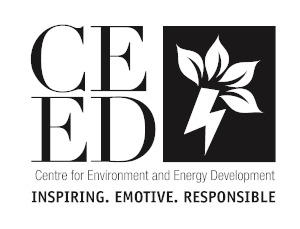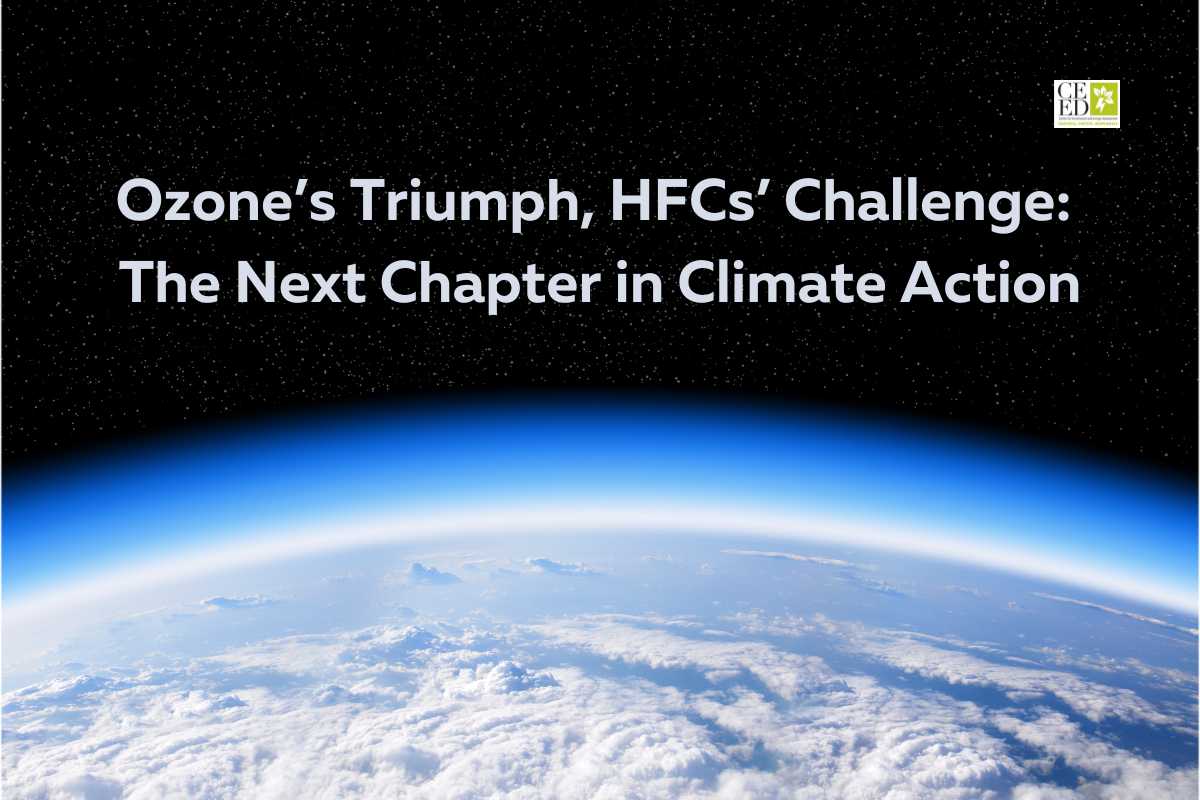Taking forward the legacy of Montreal Protocol through the Kigali Amendment
Sankar Jyoti Nath | Manish Kumar |
In a world where we often feel overwhelmed by the magnitude of environmental challenges, there emerges a beacon of hope, shining brighter than ever before. World Ozone Day 2023 doesn’t just mark a date on our calendars; it’s an example of humanity’s resilience and determination. As the latest findings celebrate the ongoing recovery of our protective ozone layer—thanks to the unyielding efforts of the Montreal Protocol—we are reminded of the profound impact collective action can have. But this isn’t just a story of restoration; it’s urging us to embrace the next chapter in our journey to ensure a cooler climate and a more sustainable future for all.
Why the Ozone Matters?
The ozone layer acts as Earth’s natural sunglasses, filtering out the sun’s harmful ultraviolet (UV) radiation. Without it, life on Earth would be at risk. Increased UV rays can lead to more cases of skin cancer, cataracts, and other UV-induced health issues. It can also affect marine ecosystems, including plankton which forms the basis of the food web.
Why did people start to worry about depleting the ozone?
The concern regarding the depletion of the Ozone layer began to gain traction around the launch of the Nimbus-7 satellite in October 1978. Two researchers from California namely Sherwood Rowland and Mario J. Molina had uncovered a previously unknown mechanism through which Chlorofluorocarbons (CFCs) – a gas prevalent in products ranging from aerosol sprays to air conditioning systems – could erode the Ozone layer. Unlike most pollutants that are naturally broken down, CFCs are non-toxic and persistent. Their long lifespan allows them to gradually ascend into the upper layers of the atmosphere, where they can initiate the degradation of the ozone layer.
This groundbreaking discovery coincided with the launch of Nimbus-7. As a result, there was mounting pressure from the scientific community and legislative bodies for us to provide evidence of the ozone’s state. A significant challenge we faced was that Nimbus-7, originally intended to function for just a year (though it impressively served for 14 years), wasn’t equipped to detect the subtle shifts in the ozone layer that researchers were then forecasting. Consequently, we were under immense pressure to produce accurate measurements to corroborate the predictions that scientists were making based on their theoretical models.
A Brief History of Preservation of the Ozone Layer
On 16 September 1987, the world came together to sign the Montreal Protocol, an international treaty aimed at phasing out the production of numerous substances responsible for ozone depletion. Its success has led to the phase-out of 99% of ozone-depleting chemicals in refrigerators, air-conditioners and many other products.

Throughout the 1970s, ’80s, and ’90s, as the levels of ozone in the stratosphere decreased, a gap formed over Antarctica. The chart depicts the expansion of the ozone hole over time. By the 1990s, it had ballooned to a staggering 25 million km², surpassing the size of Russia, which spans 16 million km². However, around the turn of the millennium, the ozone hole ceased its expansion. This stabilization can be attributed to the significant reduction in emissions of substances that deplete the ozone, leading to a halt in the decline of ozone concentrations. While the ozone hole is currently on a healing path, a complete recovery will still require several more decades.

The recent update from the Scientific Assessment Panel to the Montreal Protocol brings inspiring news: the ozone layer recovery is on track, with levels anticipated to return to those of 1980 by around 2066 over the Antarctic. The Montreal Protocol has championed our planet’s well-being for nearly four decades. By prohibiting ozone-depleting substances, this treaty isn’t just about saving the ozone – it’s about saving lives, and ecosystems, and combatting the perils of climate change.
Yet, the journey is far from over. The Kigali Amendment, a pivotal extension to the Montreal Protocol, is steering us toward the next challenge: phasing down hydrofluorocarbons (HFCs). These potent climate-warming gases stepped in as substitutes in the cooling industry after the ban on ozone-depleting substances. Our planet is growing warmer, and as the demand for cooling – be it in homes, schools, or workplaces – skyrockets, the need for sustainable cooling methods becomes paramount.
But why stop at merely replacing HFCs? Let’s aim for greater energy efficiency in our cooling equipment. If we successfully phase down HFCs, the Kigali Amendment can help avoid up to 0.5°C of warming by 2100. Now, couple this with energy efficiency measures, and we’re looking at potentially doubling that figure! As we observe this day, let’s remember the overarching message of 2023: Montreal Protocol: Fixing the Ozone Layer and Reducing Climate Change. It’s a testament to the Montreal Protocol’s monumental role in safeguarding human health, nature, and our climate.
Our Collective Success
Thanks to global cooperation and concerted efforts, we’ve made significant progress. The ozone layer is slowly recovering and is expected to return to 1980 levels by the middle of this century.
The Road Ahead
While we’ve come a long way, challenges remain. The unexpected increase in the emissions of some banned chemicals and the discovery of new ozone-depleting substances remind us that vigilance is crucial.
This International Day for the Preservation of the Ozone Layer, let’s pledge to continue our efforts:
1. Educate and Advocate: Share information about the importance of the ozone layer.
2. Choose Ozone-Friendly Products: Opt for products labelled ‘Ozone-Friendly’.
3. Support Policies: Back regulations and initiatives that promote the protection of our ozone layer.
Remember, no matter how small, every action can make a difference!
In the words of Ban Ki-moon, “The success of the Montreal Protocol should encourage us to show the same level of urgency and unity to tackle the even greater challenge of climate change.”
Together, let’s breathe a sigh of relief for our rejuvenating ozone layer and promise to keep it safe for generations to come.
References:
- Hannah Ritchie, Lucas Rodés-Guirao and Max Roser (2023) – “Ozone Layer”. Published online at OurWorldInData.org. Retrieved from: ‘https://ourworldindata.org/ozone-layer’ [Online Resource]
- NASA Ozone Watch: Latest Status of Ozone


